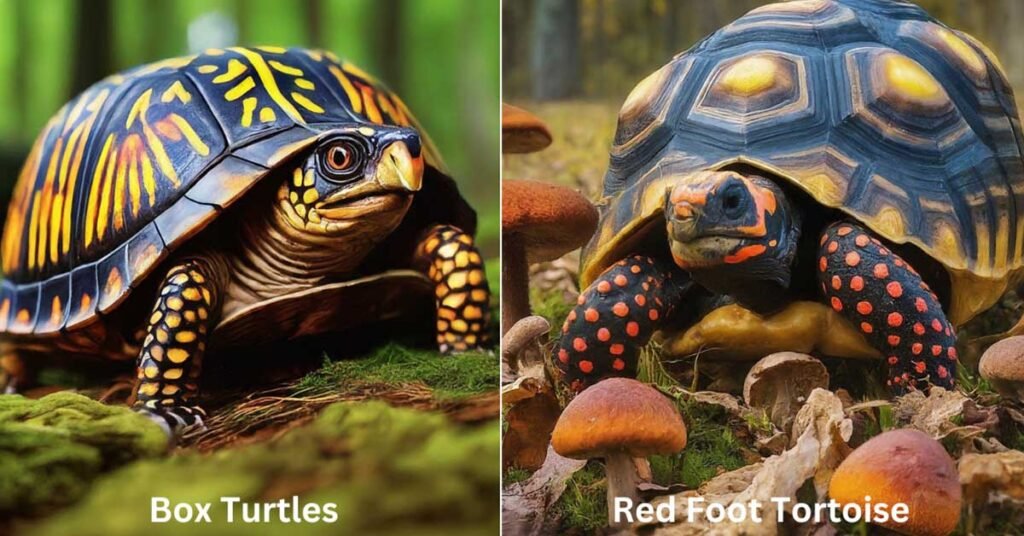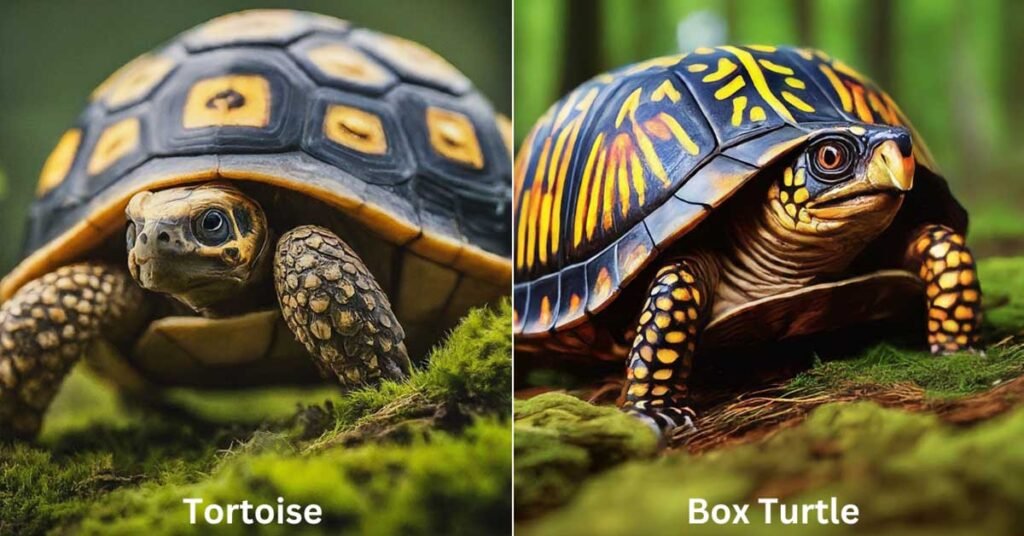All of the 356 turtle species can be referred to as turtles, including tortoises. Also, many of us refer to box turtles as tortoises. So, are box turtles tortoises? This is a common question, but there are apparent differences between the two. So, this confusion is obvious.
Box turtles belong to the Emydidae family, while tortoises are part of the Testudinidae family. Box turtles often live near water and swim, unlike tortoises. Both box turtles and tortoises have shells. But beneath their hard shells, box turtles and tortoises have distinct characteristics.
These distinctions help us distinguish each species’ unique traits. In this article, we’ll explore more about the question, “Are box turtles a turtle or a tortoise?” We will also” discuss the differences between these fascinating reptiles.
Table of Contents
Are Box Turtles Tortoises?

No, box turtles are not tortoises. Although they might appear similar, they’re distinct reptile types. Box turtles belong to the Emydidae family, while tortoises are in the Testudinidae, as we already mentioned above. Their differences include physical, diet, habitat, and behavioral features.
In the later sections, we’ll examine where they live, how they behave, and what they look like to really understand what makes them different.
Comparison Table of a Box Turtle and a Tortoise

Here, we have compiled a detailed comparison table of basic differences between box turtles and tortoises. Remember, these are basic features to differentiate. There are many different species among these two turtle types, and there might be slight differences depending on the species type.
| Aspect | Box Turtle | Tortoise |
| Scientific Classification | Kingdom: Animalia Order: TestudinesPhylum: ChordataClass: Reptilia Family: EmydidaeGenus: TerrapeneSpecies: Varies by type (e.g. – Terrapene ornata for the Ornate Box TurtleTerrapene Carolina Carolina for the Eastern Box Turtle) | Kingdom: AnimaliaOrder: TestudinesPhylum: Chordata Class: Reptilia Family: Testudinidae Suborder: Cryptodira Genus and Species: Varies by type (e.g., For example, the Indian Star Tortoise is classified as Geochelone elegans.) |
| Physical Features | Shell -Domed shell but a bit flatter than tortoise, dark plastron Foot – webbed feet with long and flattened claws | Shell – Domed shell, yellow plastron, thick, Foot – sturdy legs with heavy claws, not flattened |
| Body Size | Typically smaller, about 4-7 inches long | Generally larger, size varies widely among species |
| Shell Pattern | Rough with distinctive patterns or colorful markings | Many domed-shaped growth rings are visible on tortoise shells |
| Head Shape | Smaller, rounded head | Larger head size than box turtle, more noticeable head |
| Blood Temperature | Cold-blooded | Cold-blooded |
| Preferred Habitat | Moist areas, close to water bodies | Arid regions, well-vegetated areas |
Water Needs | High water dependence for survival | Can survive without direct water sources, gets moisture from diet |
| Dietary Habits | Omnivorous, juveniles are more carnivorous | Mainly herbivorous, opportunistic omnivores |
| Social Behavior | Often found in small groups (3-4 members), partially solitary, mildly aggressive during mating | Largely solitary, very aggressive during mating |
| Longevity | Can exceed 50 years in the wild | Can exceed 50 years in the wild |
| Geographical Spread | Found globally in various water environments | Mostly in Africa and Asia, but also found in other regions |
Detailed Differences Between Box Turtles & Tortoises

So, now we have a basic overview of the difference between box turtles and tortoises. Let’s go to the details discussion.
Bone Structure Differences
Box turtles have some unique anatomical features that make them move differently. One interesting difference is their pelvic girdle. Unlike most reptiles, it’s tucked inside their rib cage, which helps to give them a compact body.
Additionally, their vertebrae and ribs are connected straight to their shell. It might sound interesting, but it provides them with a strong, solid structure for burrowing and protection.
However, it also limits their flexibility. That’s why box turtles often have unsteady, swaying walks. It is a unique signature move that separates them from their tortoise cousins.
Tortoises, on the other hand, have a more flexible spine and a pelvic girdle positioned outside their ribcage. It allows for enhanced mobility and a more efficient walking step.
Shell Features & Differences
Shells are a big part of the box turtle and tortoise image, but can they really tell the whole story? While a shell’s shape can be a helpful clue for aquatic turtles, it gets a little trickier with land dwellers like box turtles.
It’s because box turtles, which have dome-shaped shells, can be confused with tortoises at first glance. This high dome might make them look similar, but there are ways to crack the case.
For instance, tortoise shells tend to be more rounded and even higher-domed than those of box turtles. But the real giveaway is the hinge.
Box turtles have a unique hinged bottom shell that allows them to completely hide themselves inside for ultimate protection. In contrast, tortoises have solid, non-hinged shells.
Foot Structure Differences
Take a peek at their feet, and you’ll see another clue about their differences. Box turtles have clawed feet with webbing between their toes. These are perfect for digging into the soil and even paddling through shallow water.
Their foot structure is like tiny paddles helping them explore their water or land environment. Tortoises, however, have stumpy feet that resemble an elephant’s.
These strong legs with thick pads are ideal for walking long distances and digging impressive burrows. Some tortoises can dig tunnels over 6-7 feet deep. Think of them as sturdy hiking boots for their land adventures!
While they can’t glide, their strong legs are perfectly adapted to moving long distances and digging impressive burrows.
Size Differences
Size is another way to tell them apart. Box turtles are smaller, usually grown up to about 4 to 7 inches long. Imagine them as the petite adventurers of the shelled world! Tortoises, however, come in all sizes.
Depending on the species, they can be as small as 8 inches or grow to be giants of over 30 inches long. Some pet tortoises can even weigh a lot, ranging from 1 pound to a whopping 200 pounds.
Diet Differences
Tortoises are like walking salad bars – they’re primarily herbivores. They munch on delicious vegetables, weeds, leafy greens, and sometimes even fruit.
Imagine them as nature’s lawnmowers, happily snacking their way through the day. They get most of their water from the plants they eat so that you won’t see them at watering holes very often.
Box turtles, on the other hand, are adventurous eaters – they’re omnivores. Their diet includes a variety of insects, amphibians, and, of course, plants.
When they’re young, box turtles are even more carnivorous, hunting in streams and ponds for tasty treats like insect larvae and even aquatic animal eggs. As they grow older, their diet becomes more plant-based, with roots, berries, and flowers on the menu.
Habitat differences
Box turtles are like little explorers who love a touch of moisture. They like ponds, marshes, and other watery spots to cool off and find food.
They live in all kinds of plant-filled places, including meadows, woodlands, and forests. There’s even a special box turtle, the aquatic box turtle, that makes its home right in the water.
However, tortoises are strictly land dwellers. Dry ground is their happy place, and they can adapt to a surprising range of habitats, from sandy deserts to grassy plains.
Some tortoises like a few trees for shade, but too many trees can block the sunlight they need for their shell health and a plant-based diet. That’s why tortoises like the Russian Tortoise love living in dry grasslands with plenty of sunshine.
Personalities & Lifespan
Box turtles, sometimes found in groups called “bales,” sometimes can be surprisingly social creatures. After a good rain, you might see a few box turtles hanging out together, searching for food.
However, these social gatherings aren’t permanent. Many box turtles spend a lot of time solitary, wandering around looking for perfect habitats. For most of their impressive lifespans, which can easily exceed 50 years for some species
On the other hand, tortoises are loners. They typically live solitary lives, only coming together during the mating season. Tortoises can live up to 120 years, the highest lifespan in turtle species.
Consider them solitary adventurers, roaming the land and basking in the sun at their own pace. When mating season starts, their normal behavior changes, but once it’s over, they’re solitary again.
Similarities Between Box Turtles & Tortoises

So, now that we know the basic differences between box turtles and tortoises, are there any similarities between them? Of course, there are! They are both reptilian turtles, so similarities are one of the most common factors.
Built-in Armor: Both have tough shells for protection, an essential part of their skeleton.
Diet: They’re mostly vegetarians, loving fruits and veggies.
Sun Seekers: They rely on sunshine to stay warm, acting like living sundials.
Buried Babies: They lay eggs hidden underground for their young to hatch.
Mostly Solitary: They’re loners, only meeting during mating season for a brief social gathering.
Why Are Box Turtles Not Tortoises?
Box turtles and tortoises might look similar in their shells, but they’re actually classified as different types of reptiles.
Box turtles are called turtles, and one of the main reasons is their habitat preference. Tortoises are land dwellers, but turtles can live in both water and land environments.
So, this gives you a clear answer as to why box turtles are not called tortoises. The box turtle prefers moist environments near water, while tortoises like deserts and grasslands.
Though both can eat plants, box turtles are generally omnivores, occasionally enjoying insects and small animals. Tortoises are primarily herbivores.
Box turtles tend to be on the smaller side, typically growing to 4-7 inches. Meanwhile, tortoises come in a wide range of sizes, from compact 8 inches to giants exceeding 30 inches.
Read More: Can A Box Turtle Swim?
Wrapping Up
Did you get the answers to this question now: “Are box turtles turtles or tortoises?” The clear answer is that box turtles are specifically turtles, not tortoises. Why are they not called tortoises, and what are the differences between tortoises? We have covered all the details to remove your confusion.
